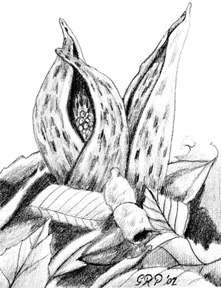 In Season: Skunk Cabbage
In Season: Skunk Cabbage
by Gary Pendleton
It is January and all seems bleak, so with pen in hand I turn to the skunk cabbage.
It has that unfortunate name, it smells bad — this goes along with the name — and it is not very pretty. With those three strikes against it, the plant must have something going for it. And it does.
The stalwart skunk cabbage is the first flower to bloom in the new year. It pushes up through the wetlands soil in January, sometimes as early as December — which would make it the last plant to bloom, wouldn’t it? Through a biological process, it is even able to melt snow and ice so that it may go about its business. The pungent aroma has a purpose, too: The scent attracts flies and beetles for pollination.
Skunk cabbage is in the Arum family, related to jack-in-the pulpit and arrow arum, also wetland plants. The green-and-purple flower petals are fused together, forming what is called a spaeth. This is a semi-enclosed area that protects the spadix, the sexual part of the flower. Within the spaeth, it can be 30 degrees warmer than the surrounding air. The terms spaeth and spadix by the way, are unique to the arum family.
The skunk cabbage produces large, fleshy leaves that come up after the flower fades. For some Native Americans, these were some of the earliest leafy greens and an important source of vitamins in early spring after a long season of dried grains and meat. Before eating any part of the plant, they carefully processed it to eliminate calcium oxalate crystals, which have an unpleasant, burning taste.
I try to convince myself that I like winter: the occasional snow fall, the heavy afternoon light that falls on sunny days, the dramatic sunsets. I do appreciate the change of seasons and the variety that it provides. Still, I need some inspiration to endure the long nights, the gray days and chill. The humble skunk cabbage satisfies my need, rising to the occasion through the wetland muck. It is more than a hardy native plant quietly filling an ecological niche.
Fortunately, I do not need to eat the skunk cabbage for vitamins and minerals. I have green, leafy alternatives for my diet that don’t come with the calcium oxalate. Still, the message from the skunk cabbage is to hang on, spring is coming. It is a homely reminder that life goes on and a vigorous example of perseverance through hard times.